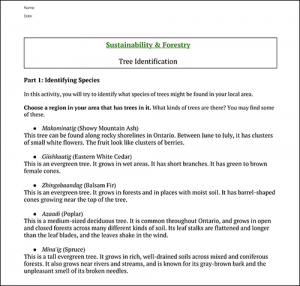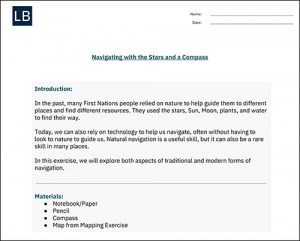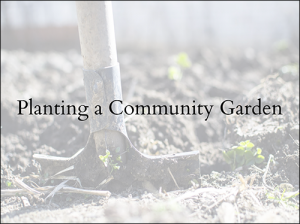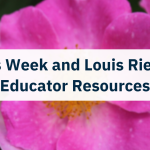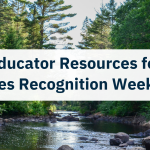Successful Outdoor Learning
Are you interested in exploring how to integrate outdoor learning into your teaching? You may be hearing more about the benefits of taking your learners outside to explore green spaces, forests, and other natural environments.
Many experts agree that learners find it easier to pay attention, make connections, and relate to their peers while learning outdoors. As an educator, you may even feel less stressed while teaching outside.
The Formula for Successful Outdoor Learning
However, it can be hard to balance curriculum expectations, administrator expectations, and outdoor learning. Part of this challenge is finding ways to incorporate the outdoors into what you’re already teaching. Learning to include the outdoors as part of your curriculum-driven instruction can help reduce some of these competing demands on you and your learners’ time. Let’s explore planning for success and ideas for incorporating more outdoor time in your classes without sacrificing instructional time.
Start Small
Starting small is always helpful. If you struggle to find ways to connect your curricular outcomes with natural spaces, think about simply holding class outside. If learners work independently or in small groups on projects that don’t require many materials, consider taking learners outside to work. There will be more space for learners to spread out. Learners can freely speak at a higher volume. They will benefit from the creativity the outdoors brings.
One of our team members recently took a group of educators outside during a professional development workshop. She walked with them around the school grounds, discussing setting up an outdoor classroom space. They found tree stumps and large rocks they could use for seating and set up a physical area in the schoolyard to act as an outdoor classroom. She stressed that outdoor education doesn’t only mean field trips, going out in the bush or on the land, or complicated pre-planned activities requiring special equipment. It can be as simple as taking a paper handout outside with your learners or moving your existing work into an outdoor setting.
Factor for Weather
Inclement weather doesn’t always mean you need to stay in. If your learners have access to appropriate clothing, take them out in the rain to see insects they may not have realized inhabit the same land as they do. Take them out in the snow to have snowball fights and see the results of their velocity and parabola equations, or make structures like the ones they have been studying in geometry. Ask learners to write about what they encounter while learning outside. Encourage them to embrace and truly experience the land Canadian and Indigenous literature and oral stories describe and portray.
If you don’t feel comfortable taking learners out in the rain or cold weather, use those days to plan activities for better weather. You can do research, prepare materials, plan, and collaborate inside to be ready to start the day bright and early when the weather gets better.
Ask for Help
If your school has outdoor education or language and culture educators or Elders on staff, connect with them to brainstorm creative ways to incorporate the outdoors in your curriculum. This may involve new cross-curricular projects, guest speakers who bring learners outside, or even additional class, grade, or school outings to explore the schoolyard and nearby land. What you can achieve when collaborating with your fellow educators and staff is amazing.
Outdoor Learning Suggestions for English Language Arts
Learning from and in nature can help learners form better connections to what they are learning. Learners engage by seeing, touching, and hearing what they learn. Descriptive writing can be a fun outdoor activity. One way to introduce descriptive writing to your learners is by asking them to imagine their favourite place or food and write about it. It is also an easy way to bring your learners outside to learn. This resource from Treaty Six Education Council asks learners to practice descriptive writing in a few ways, including on a nature walk and using their five senses.
Here’s a pro tip: Ask your learners to write about a sixth sense: how they feel outside. This can help learners connect to the land deeper, more intentionally, and more meaningfully. It also introduces a new dimension to their writing, making it more impactful and engaging.
Outdoor Learning Suggestions for Math
Math can be a tricky subject to imagine teaching outside. The numbers, formulas, and calculators seem to lend themselves to the indoors. However, you can open up your classroom space to the fresh air with some planning and outside-the-box thinking. This resource from Eabametoong First Nation has learners head out onto the land near their homes to identify tree species and calculate percentages. The objective of this resource is to discover which tree species is most abundant. You can also use this resource as a jumping-off point for discussing other uses for math in forestry and sustainability, including topics like statistics and geometry.
Don’t have a forest near your school? Try this activity in a park instead. This exercise can facilitate interesting cross-curricular discussions about populations of species, biodiversity, and planned versus wild spaces.
Outdoor Learning Suggestions for Science
Celestial navigation, and even orienteering, may feel outdated. However, they still hold value when you’re out in the woods with no phone signal. Beyond that, these forms of navigation can be gateways to complex scientific domains, like astronomy, earth sciences, and physics. As you learn about constellations and lunar and solar orbits, take your learners stargazing and show them how to orient themselves. As you’re learning about magnetic poles or magnetism in general, pull out a compass and have learners find their way to a set point in your community.
This resource from Treaty Six Education Council forms part of a resource kit introducing learners to navigational methods throughout history. It gives them practical tips on using them themselves. This resource asks learners to show what they’ve learned by navigating using their compasses and sharing their knowledge of the skies. It also suggests going out with an Elder to learn even more natural navigation methods.
How can you navigate using the stars during daylight school hours? This resource kit answers that question for you. If you’d like to show your learners some constellations, take your learners outside during the first or last period of the day during winter. As long as you dress appropriately and don’t stay out too long, you’ll be able to show your learners the night sky. Alternatively, consider finding an app that shows a constellation map in augmented reality (AR). You could download it to your class iPads or even your cell phone. That will enable you and your learners to find constellations even during the daytime.
Outdoor Learning Suggestions for Social Studies
A field trip to a historical site or museum seems like the only way to bring social studies outside. Field trips definitely have their place, but they are not the only option or opportunity to leave the classroom. This resource from Eabametoong First Nation is part of a resource kit full of activities you can do outside, including making a community garden and planting trees. The learning in this resource kit can spark discussions about Indigenous rights, economic equity, food security and sustainability. These activities have the added benefit of supporting cross-curricular learning in math and science. This resource outlines what learners need to know to plant a community garden.
The activities outlined above will certainly require a lot of planning. However, there are “lighter” versions of these activities you could have your learners participate in. Instead of creating a community garden or planting trees in the bush, go outside and create a smaller garden. Plant some trees on school grounds, or let learners pot some plants in individual planters. You can bring the planters back to your classroom to create a greener indoor environment as a bonus.
I’ve introduced a few ways to bring your learners outside during class. There are many ways to do this, and you can make many links between topics you teach and the outdoors. Have you already been taking your learners outside to learn? If so, what activities have you tried? Have you used any of these resources or suggestions in your own practice? Please email us and let us know how it went.




